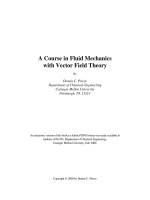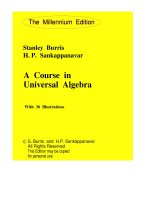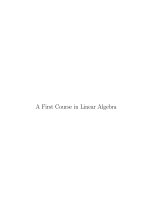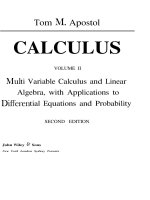A course in linear algebra with applications, 2006
Bạn đang xem bản rút gọn của tài liệu. Xem và tải ngay bản đầy đủ của tài liệu tại đây (13.28 MB, 453 trang )
A Course in
LINEAR ALGEBRA
with Applications
Derek J. S. Robinson
A Course in
LINEAR ALGEBRA
with Applications
2nd Edition
2nd Edition
il^f£%M
ik.
J
5%
9%tf"%I'll S t i f f e n
University of Illinois in Urbana-Champaign, USA
l | 0 World Scientific
NEW JERSEY • LONDON • SINGAPORE • BEIJING • SHANGHAI • HONG KONG • TAIPEI • CHENNAI
Published by
World Scientific Publishing Co. Pte. Ltd.
5 Toh Tuck Link, Singapore 596224
USA office: 27 Warren Street, Suite 401-402, Hackensack, NJ 07601
UK office: 57 Shelton Street, Covent Garden, London WC2H 9HE
British Library Cataloguing-in-Publication Data
A catalogue record for this book is available from the British Library.
A COURSE IN LINEAR ALGEBRA WITH APPLICATIONS (2nd Edition)
Copyright © 2006 by World Scientific Publishing Co. Pte. Ltd.
All rights reserved. This book, or parts thereof, may not be reproduced in any form or by any means,
electronic or mechanical, including photocopying, recording or any information storage and retrieval
system now known or to be invented, without written permission from the Publisher.
For photocopying of material in this volume, please pay a copying fee through the Copyright
Clearance Center, Inc., 222 Rosewood Drive, Danvers, MA 01923, USA. In this case permission to
photocopy is not required from the publisher.
ISBN 981-270-023-4
ISBN 981-270-024-2 (pbk)
Printed in Singapore by B & JO Enterprise
For
JUDITH, EWAN and GAVIN
P R E F A C E T O T H E SECOND E D I T I O N
The principal change from the first edition is the addition of
a new chapter on linear programming. While linear programming is one of the most widely used and successful applications
of linear algebra, it rarely appears in a text such as this. In
the new Chapter Ten the theoretical basis of the simplex algorithm is carefully explained and its geometrical interpretation
is stressed.
Some further applications of linear algebra have been
added, for example the use of Jordan normal form to solve
systems of linear differential equations and a discussion of extremal values of quadratic forms.
On the theoretical side, the concepts of coset and quotient
space are thoroughly explained in Chapter 5. Cosets have
useful interpretations as solutions sets of systems of linear
equations. In addition the Isomorphisms Theorems for vector
spaces are developed in Chapter Six: these shed light on the
relationship between subspaces and quotient spaces.
The opportunity has also been taken to add further exercises, revise the exposition in several places and correct a few
errors. Hopefully these improvements will increase the usefulness of the book to anyone who needs to have a thorough
knowledge of linear algebra and its applications.
I am grateful to Ms. Tan Rok Ting of World Scientific
for assistance with the production of this new edition and for
patience in the face of missed deadlines. I thank my family
for their support during the preparation of the manuscript.
Derek Robinson
Urbana, Illinois
May 2006
vii
P R E F A C E TO T H E F I R S T E D I T I O N
A rough and ready definition of linear algebra might be: that
part of algebra which is concerned with quantities of the first
degree. Thus, at the very simplest level, it involves the solution of systems of linear equations, and in a real sense this
elementary problem underlies the whole subject. Of all the
branches of algebra, linear algebra is the one which has found
the widest range of applications. Indeed there are few areas
of the mathematical, physical and social sciences which have
not benefitted from its power and precision. For anyone working in these fields a thorough knowledge of linear algebra has
become an indispensable tool. A recent feature is the greater
mathematical sophistication of users of the subject, due in
part to the increasing use of algebra in the information sciences. At any rate it is no longer enough simply to be able to
perform Gaussian elimination and deal with real vector spaces
of dimensions two and three.
The aim of this book is to give a comprehensive introduction to the core areas of linear algebra, while at the same
time providing a selection of applications. We have taken the
point of view that it is better to consider a few quality applications in depth, rather than attempt the almost impossible task
of covering all conceivable applications that potential readers
might have in mind.
The reader is not assumed to have any previous knowledge of linear algebra - though in practice many will - but
is expected to have at least the mathematical maturity of a
student who has completed the calculus sequence. In North
America such a student will probably be in the second or third
year of study.
The book begins with a thorough discussion of matrix
operations. It is perhaps unfashionable to precede systems
of linear equations by matrices, but I feel that the central
ix
X
Preface
position of matrices in the entire theory makes this a logical
and reasonable course. However the motivation for the introduction of matrices, by means of linear equations, is still
provided informally. The second chapter forms a basis for
the whole subject with a full account of the theory of linear
equations. This is followed by a chapter on determinants, a
topic that has been unfairly neglected recently. In practice it
is hard to give a satisfactory definition of the general n x n
determinant without using permutations, so a brief account
of these is given.
Chapters Five and Six introduce the student to vector
spaces. The concept of an abstract vector space is probably
the most challenging one in the entire subject for the nonmathematician, but it is a concept which is well worth the
effort of mastering. Our approach proceeds in gentle stages,
through a series of examples that exhibit the essential features of a vector space; only then are the details of the definition written down. However I feel that nothing is gained
by ducking the issue and omitting the definition entirely, as is
sometimes done.
Linear tranformations are the subject of Chapter Six.
After a brief introduction to functional notation, and numerous examples of linear transformations, a thorough account
of the relation between linear transformations and matrices is
given. In addition both kernel and image are introduced and
are related to the null and column spaces of a matrix.
Orthogonality, perhaps the heart of the subject, receives
an extended treatment in Chapter Seven. After a gentle introduction by way of scalar products in three dimensions —
which will be familiar to the student from calculus — inner
product spaces are denned and the Gram-Schmidt procedure
is described. The chapter concludes with a detailed account
of The Method of Least Squares, including the problem of
Preface
xi
finding optimal solutions, which texts at this level often fail
to cover.
Chapter Eight introduces the reader to the theory of
eigenvectors and eigenvalues, still one of the most powerful
tools in linear algebra. Included is a detailed account of applications to systems of linear differential equations and linear
recurrences, and also to Markov processes. Here we have not
shied away from the more difficult case where the eigenvalues
of the coefficient matrix are not all different.
The final chapter contains a selection of more advanced
topics in linear algebra, including the crucial Spectral Theorem on the diagonalizability of real symmetric matrices. The
usual applications of this result to quadratic forms, conies
and quadrics, and maxima and minima of functions of several
variables follow.
Also included in Chapter Nine are treatments of bilinear
forms and Jordan Normal Form, topics that are often not considered in texts at this level, but which should be more widely
known. In particular, canonical forms for both symmetric and
skew-symmetric bilinear forms are obtained. Finally, Jordan
Normal Form is presented by an accessible approach that requires only an elementary knowledge of vector spaces.
Chapters One to Eight, together with Sections 9.1 and
9.2, correspond approximately to a one semester course taught
by the author over a period of many years. As time allows,
other topics from Chapter Nine may be included. In practice
some of the contents of Chapters One and Two will already be
familiar to many readers and can be treated as review. Full
proofs are almost always included: no doubt some instructors
may not wish to cover all of them, but it is stressed that for
maximum understanding of the material as many proofs as
possible should be read. A good supply of problems appears
at the end of each section. As always in mathematics, it is an
xii
Preface
indispensible part of learning the subject to attempt as many
problems as possible.
This book was originally begun at the suggestion of
Harriet McQuarrie. I thank Ms. Ho Hwei Moon of World
Scientific Publishing Company for her advice and for help with
editorial work. I am grateful to my family for their patience,
and to my wife Judith for her encouragement, and for assistance with the proof-reading.
Derek Robinson
Singapore
March 1991
CONTENTS
Preface to the Second Edition
Preface to the First Edition
Chapter One
1
6
24
Systems of Linear Equations
2.1 Gaussian Elimination
2.2 Elementary Row Operations
2.3 Elementary Matrices
Chapter Three
ix
Matrix Algebra
1.1 Matrices
1.2 Operations with Matrices
1.3 Matrices over Rings and Fields
Chapter Two
vii
30
41
47
Determinants
3.1 Permutations and the Definition of a
Determinant
3.2 Basic Properties of Determinants
3.3 Determinants and Inverses of Matrices
xm
57
70
78
xiv
Contents
Chapter Four
Introduction to Vector Spaces
4.1 Examples of Vector Spaces
4.2 Vector Spaces and Subspaces
4.3 Linear Independence in Vector Spaces
Chapter Five
Basis and Dimension
5.1 The Existence of a Basis
5.2 The Row and Column Spaces of a Matrix
5.3 Operations with Subspaces
Chapter Six
152
158
178
Orthogonality in Vector Spaces
7.1 Scalar Products in Euclidean Space
7.2 Inner Product Spaces
7.3 Orthonormal Sets and the Gram-Schmidt
Process
7.4 The Method of Least Squares
Chapter Eight
112
126
133
Linear Transformations
6.1 Functions Defined on Sets
6.2 Linear Transformations and Matrices
6.3 Kernel, Image and Isomorphism
Chapter Seven
87
95
104
193
209
226
241
Eigenvectors and Eigenvalues
8.1 Basic Theory of Eigenvectors and Eigenvalues
8.2 Applications to Systems of Linear Recurrences
8.3 Applications to Systems of Linear Differential
Equations
257
276
288
Contents
Chapter Nine
XV
More Advanced Topics
9.1 Eigenvalues and Eigenvectors of Symmetric and
Hermitian Matrices
303
9.2 Quadratic Forms
313
9.3 Bilinear Forms
332
9.4 Minimum Polynomials and Jordan Normal
Form
347
Chapter Ten
10.1
10.2
10.3
10.4
Linear Programming
Introduction to Linear Programming
The Geometry of Linear Programming
Basic Solutions and Extreme Points
The Simplex Algorithm
Appendix
Mathematical Induction
370
380
391
399
415
Answers to the Exercises
418
Bibliography
430
Index
432
Chapter One
MATRIX ALGEBRA
In this first chapter we shall introduce one of the principal objects of study in linear algebra, a matrix or rectangular array of numbers, together with the standard matrix
operations. Matrices are encountered frequently in many areas of mathematics, engineering, and the physical and social
sciences, typically when data is given in tabular form. But
perhaps the most familiar situation in which matrices arise is
in the solution of systems of linear equations.
1.1 Matrices
An m x n matrix A is a rectangular array of numbers,
real or complex, with m rows and n columns. We shall write
dij for the number that appears in the ith row and the jth
column of A; this is called the (i,j) entry of A. We can either
write A in the extended form
/ an
&12
•••
CL\n
«22
- -
&2n
'
\
«21
' ' '
Q"m2
Q"mn '
V&rol
or in the more compact form
Thus in the compact form a formula for the (i,j) entry of A
is given inside the round brackets, while the subscripts m and
n tell us the respective numbers of rows and columns of A.
1
2
Chapter One: Matrix Algebra
Explicit examples of matrices are
/4
[l
3\
2)
and
, /
0 2.4
{^=2
3/5
6\
-lj-
Example 1.1.1
Write down the extended form of the matrix ( ( - l ) * j + 1)3,2 •
The (i,j) entry of the matrix is (—l)lj + i where i — 1,
2, 3, and j — 1, 2. So the matrix is
(1 "0It is necessary to decide when two matrices A and B are
to be regarded as equal; in symbols A = B. Let us agree this
will mean that the matrices A and B have the same numbers
of rows and columns, and that, for all i and j , the (i,j) entry
of A equals the (i,j) entry of B. In short, two matrices are
equal if they look exactly alike.
As has already been mentioned, matrices arise when one
has to deal with linear equations. We shall now explain how
this comes about. Suppose we have a set of m linear equations
in n unknowns xi, X2, •••, xn. These may be written in the
form
{
anxi
+
CL21X1 +
o m iXi
+
CL12X2
a22X2
am2x2
+
•••
+
•••
+
•••
+
+
a\nxn
a2nXn
+
=
=
bi
£>2
a
Here the a^ and bi are to be regarded as given numbers. The
problem is to solve the system, that is, to find all n-tuples
of numbers xi, x2, ..., xn that satisfy every equation of the
3
1.1: Matrices
system, or to show that no such numbers exist. Solving a set
of linear equations is in many ways the most basic problem of
linear algebra.
The reader will probably have noticed that there is a matrix involved in the above linear system, namely the coefficient
matrix
•"•
==
y&ij
)m,n-
In fact there is a second matrix present; it is obtained by using
the numbers bi, b2, ••., bmto add a new column, the (n + l)th,
to the coefficient matrix A. This results in an m x (n + 1)
matrix called the augmented matrix of the linear system. The
problem of solving linear systems will be taken up in earnest
in Chapter Two, where it will emerge that the coefficient and
augmented matrices play a critical role. At this point we
merely wish to point out that here is a natural problem in
which matrices are involved in an essential way.
Example 1.1.2
The coefficient and augmented matrices of the pair of linear
equations
2xi —3x2 +5a;3 = 1
^ -xx
+ x2 - x3
=4
are respectively
2 - 3
5\
, f 2 -3
and
-1
1-17
V -1
5 1
1 - 1 4
Some special matrices
Certain special types of matrices that occur frequently
will now be recorded.
(i) A 1 x n matrix, or n — row vector, A has a single row
A = (an a12 ... aln).
4
Chapter One: Matrix Algebra
(ii) An m x 1 matrix, or m-column vector, B has just one
column
b2i
B =
\bml/
(iii) A matrix with the same number of rows and columns is
said to be square.
(iv) A zero matrix is a matrix all of whose entries are zero.
The zero m x n matrix is denoted by
0mn or simply 0.
Sometimes 0nn is written 0 n . For example, O23 is the matrix
0
0
0
0
0
0
(v) The identity nxn matrix has l's on the principal diagonal,
that is, from top left to bottom right, and zeros elsewhere; thus
it has the form
(\
0 •••
1^
0 1 ••• 0
\0
0
•••
1 /
This matrix is written
In
or
simply I.
The identity matrix plays the role of the number 1 in matrix
multiplication.
(vi) A square matrix is called upper triangular if it has only
zero entries below the principal diagonal. Similarly a matrix
5
1.1: Matrices
is lower triangular if all entries above the principal diagonal
are zero. For example, the matrices
are upper triangular and lower triangular respectively.
(vii) A square matrix in which all the non-zero elements lie
on the principal diagonal is called a diagonal matrix. A scalar
matrix is a diagonal matrix in which the elements on the principal diagonal are all equal. For example, the matrices
a
0
0
0 0\
6 0
0 c /
and
fa
0
\0
0 0
a 0
0 a
are respectively diagonal and scalar. Diagonal matrices have
much simpler algebraic properties than general square matrices.
Exercises 1.1
1. Write out in extended form the matrix ((—\)l~^(i + j))2,42. Find a formula for the (i,j) entry of each of the following
matrices:
(a)
-1
1
-1
1 -1
-1
1
1 -1
/I
, (b)
5
9
\13
2
6
10
14
3
7
11
15
4
8
12
16
6
Chapter One: Matrix Algebra
3. Using the fact that matrices have a rectangular shape, say
how many different zero matrices can be formed using a total
of 12 zeros.
4. For every integer n > 1 there are always at least two zero
matrices that can be formed using a total of n zeros. For
which n are there exactly two such zero matrices?
5. Which matrices are both upper and lower triangular?
1.2 Operations with Matrices
We shall now introduce a number of standard operations
that can be performed on matrices, among them addition,
scalar multiplication and multiplication. We shall then describe the principal properties of these operations. Our object
in so doing is to develop a systematic means of performing calculations with matrices.
(i) Addition and subtraction
Let A and B be two mxn matrices; as usual write a^ and bij
for their respective (i,j) entries. Define the sum A + B to be
the mxn matrix whose (i,j) entry is a^ + b^; thus to form
the matrix A + B we simply add corresponding entries of A
and B. Similarly, the difference A — B is the mxn
matrix
whose (i,j) entry is a^- — b^. However A + B and A — B
are not defined if A and B do not have the same numbers of
rows and columns.
(ii) Scalar multiplication
By a scalar we shall mean a number, as opposed to a matrix
or array of numbers. Let c be a scalar and A an mxn matrix.
The scalar multiple cA is the mxn matrix whose (i, j) entry
is caij. Thus to form cA we multiply every entry of A by the
scalar c. The matrix ( - l ) A is usually written -A; it is called
the negative of A since it has the property that A + (-A) = 0.
7
1.2: Operations with Matrices
Example 1.2.1
If
,
/ 1 2 0\
, „
(I
A
dB
={-1
0 l) ™ ={0
1 1
-3 1
then
2A + 3 5 = [
X
A " I and 2A - 3 5
(iii) Matrix multiplication
It is less obvious what the "natural" definition of the
product of two matrices should be. Let us start with the
simplest interesting case, and consider a pair of 2 x 2 matrices
A= (
a lLn
\G21
a12\ , , D
^ and B -
( blx
, ,
bX2
.
0122/
\021
022
In order to motivate the definition of the matrix product AB
we consider two sets of linear equations
a\iVi + a.i2V2 = xi
o.2iV\ + a22y2 = x2
and
f &nzx + bX2z2 = y±
\ b21zi + b22z2 = y2
Observe that the coefficient matrices of these linear systems
are A and B respectively. We shall think of these equations
as representing changes of variables from j/i, y2 to xi, x2, and
from z\, z2 to y\, y2 respectively.
Suppose that we replace y\ and y2 in the first set of equations by the values specified in the second set. After simplification we obtain a new set of equations
(aii&n + ai2b2i)zi + (a U 0 1 2 + ai2b22)z2 = %i
(a21bn + a22b2i)zi + (a2ib12 + a22b22)z2 = x2
8
Chapter One: Matrix Algebra
This has coefficient matrix
a i i & n + ai2&2i
«21&11 + C122&21
011612 + 012622^
^21^12 + ^22^22 /
and represents a change of variables from zi, z2 to xi, x2 which
may be thought of as the composite of the original changes of
variables.
At first sight this new matrix looks formidable. However
it is in fact obtained from A and B in quite a simple fashion,
namely by the row-times-column rule. For example, the (1,2)
entry arises from multiplying corresponding entries of row 1 of
A and column 2 of B, and then adding the resulting numbers;
thus
(an
a12)
&12
Qll^l2 + Oi2^22-
^22
Other entries arise in a similar fashion from a row of A and a
column of B.
Having made this observation, we are now ready to define
the product AB where A is an m x n matrix and B i s a n n x p
matrix. The rule is that the (i,j) entry of AB is obtained by
multiplying corresponding entries of row i of A and column j
of B, and then adding up the resulting products. This is the
row-times-column rule. Now row i of A and column j of B are
/ bij \
an a%2
ain)
and
->2j
\ bnj /
Hence the (i,j) entry of AB is
Uilblj
+ CLi202j + • - • + O-inbnj,
9
1.2: Operations with Matrices
which can be written more concisely using the summation
notation as
n
fc=l
Notice that the rule only makes sense if the number of
columns of A equals the number of rows of B. Also the product
of an m x n matrix and a n n x p matrix is an m x p matrix.
Example 1.2.2
Let
A={
1 I 21
and B
Since A is 2 x 3 and B is 3 x 3, we see that AB is defined
and is a 2 x 3 matrix. However BA is not defined. Using the
row-times-column rule, we quickly find that
AB =
Example 1.2.3
Let
A=
0
2
( O i)and
0
16
2
-2
B=
(I i
In this case both AB and BA are defined, but these matrices
are different:
AB=rQ
°)=0
2 2 M 1
dBA=(°
l









